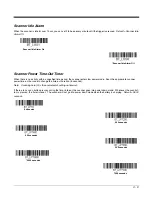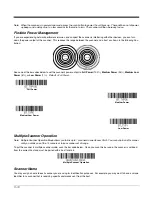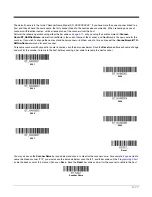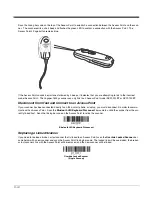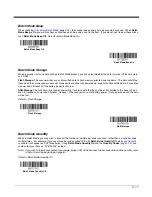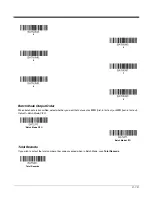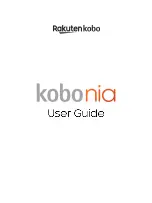
3 - 21
Host Acknowledgment
Some applications require that the host validate incoming bar code data (database look-up) and provide acknowledgment to the
scanner whether or not to proceed. In Host ACK Mode, the scanner waits for this acknowledgment after each scan. Visual and
audible acknowledgments provide valuable feedback to the scan operator. The Host ACK functionality is controlled via a num-
ber of pre-defined escape commands that are sent to the scanner to make it behave in different ways.
Note: System performance degrades when using Host ACK at rates lower than 9600 baud.
The following criteria must be met for the Host ACK to work correctly:
•
The scanner must be paired with a Honeywell Access Point (AP01-010BT or AP01-100BT).
•
The wireless system must be configured for Host Port RS232 (terminal ID = 000) or USB COM Emulation (terminal ID = 130).
•
RTS/CTS is defaulted off. You must enable it if the host system requires it.
•
Host ACK must be set to On (
).
•
A comma must be used as a terminator.
•
The host terminal software must be capable of interpreting the bar code data, make decisions based on the data content, and
send out appropriate escape commands to the scanner.
Escape commands are addressed to the scanner via Application Work Groups. Once a command is sent, all scanners in a
group respond to that command. Because of this,
it is recommended that each scanner is assigned to its own group in
Host ACK mode
.
The commands to which the scanner responds are listed on
. The
[ESC]
is a
1B
in hex. A typical command string is
y [ESC] x,
where “y” is the application work group number, “[ESC] x” is the escape command, and the comma is the terminator,
which is required. (When “y” is not specified, the command is sent to the default Application Work Group 0.)
Example:
Commands may be strung together to create custom response sequences. An example of a command string is listed
below.
0[ESC]4,[ESC]5,[ESC]6,
The above example will make a scanner that is in application work group zero beep low, then medium, then high.
Example:
A good read beep is required for any item on file, but a razz or error tone is required if the item is not on file. In this
case,
[ESC]7, is sent to the host for an on-file product
[ESC]8,[ESC]8, is sent to the host for a not-on-file product
When a bar code is scanned, the scanner enters a timeout period until either the host ACK sequence is received, or the timeout
expires (in 10 seconds, by default).
Once Host ACK is enabled, the system works as follows when a bar code is scanned:
•
The scanner reads the code and sends data to the host. No audible or visual indication is emitted until the scanner receives
an escape command. The scanner read illumination goes out when there’s a successful read.
•
Scanner operation is suspended until 1) a valid escape string is received from the host or 2) the scanner times out.
•
Once condition 1 or 2 above has been met, the scanner is ready to scan again, and the process repeats.
A time-out occurs if the scanner does not receive a valid escape command within 10 seconds. A time-out is indicated by an
error tone. If a time-out occurs, the operator should check the host system to understand why a response to the scanner was
not received.
Summary of Contents for Voyager 1602g
Page 1: ...Voyager 1602g Wireless Area Imaging Pocket Scanner User s Guide ...
Page 10: ...viii ...
Page 12: ...x ...
Page 84: ...4 20 Upright Vertical Bottom to Top Upside Down Vertical Top to Bottom ...
Page 100: ...6 12 ...
Page 150: ...7 50 ...
Page 180: ...10 24 ...
Page 184: ...11 4 ...
Page 188: ...12 4 ...



